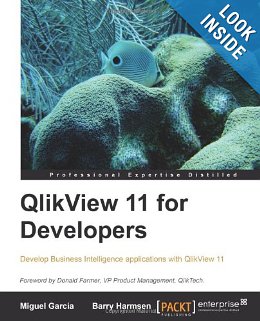 If you are reading this blog, I know that you want to learn Qlikview. Or, you are already a seasoned Qlikview developer and you are trying to become awesome in Qlikview development.
If you are reading this blog, I know that you want to learn Qlikview. Or, you are already a seasoned Qlikview developer and you are trying to become awesome in Qlikview development.
No matter where you are in your quest to learn Qlikview, you have another resource at your disposal to become a better Qlikview developer. Qlikview 11 for developers, a book written by Barry Harmsen and Miguel Garcia, is one of the best resources for novice and advanced Qlikview developers alike.
Qlikview 11 for developers is the first book that takes you from the basics to 10000 feet high using none other than a high-flying, fictional airline company data set.
As I read this book, I liked the Qlikview tutorial approach both authors have used throughout to cover each topic using same fictional company example. It’s hard to compare class room training with a book, but both authors have done brilliant work of assimilating class room environment by building Qlikview application over the course of 14 chapters.
Why do you need this book?
QlikTech has given away wealth of free training on its site. Qlikview community is also a wonderful source of information for any Qlikview developer. Nonetheless, I am an avid reader. I like to collect best of the breed books that I can refer to to enhance my knowledge. This book is definitely one of my must resources when it comes to Qlikview development.
The book starts with Qlikview’s associative architecture so that you can understand nuts and bolts behind the amazing speed with which Qlikview provides insight.
You will learn how to build a simple Qlikview document containing dimensions and expressions. You will see a simple Qlikview data model at first hand from the very beginning.
If you have worked in the business intelligence, you already know about star schema. Like other business intelligence tools, Qlikview prefers star schema. But, often, we all have to deal with snow flakes and this book covers different data source along — with best data modeling practices — with practical examples to reinforce these essential concepts rather well.
The book explores designer concepts such as different charts, styling and ways to add interactivity to the Qlikview document.
Qlikview Scripting
Qlikview scripting is the core of this book for any developer. One of the conundrums you will face as a developer is to decide when to use join or concatenate. This book covers both topics well so that you can use join or concatenate as needed.
For those of you who have never done any development in Qlikview, this book takes you from the nuances of the script editor to advance topics such as mapping load and script debugging in a tutorial fashion.
You will learn why it is important to pay attention to the tab order in your script as scripting engine works from left to right. You will also master concept of using previously loaded table with resident load.
I am a big fan of Rob Wunderlich and his open souce script library, Qlikview components(QVC). This book covers how you can use QVC functions and subroutines to automate different tasks such as incremental load.
Set Analysis
This is my favorite subject. Set Analysis allows you to perform comparative analysis and Miguel Garcia has written an excellent chapter on how you can use Set Analysis in Qlikview for point in time reporting.
Advanced Expressions
Once you master the concept of Set Analysis, you will soon learn that by using variables and dollar sign expansion(DSE), you can create dynamic data sets on the fly. In other words, you can combine power of Set Analysis with advanced expressions to expand your creativity as a Qlikview developer to a next level.
Advanced Data Transformations
After mastering essential concepts as a developer, the book takes you to a new high with its airline example to explore topics such as resident load, interval match function to deal with slowly changing dimensions, and other very useful aggregation functions in Qlikview.
This book impressed me with its depth of quality content along with tutorial style approach so that a beginner can learn each concept step-by-step while using same example throughout the book.
If you are considering a career as a Qlikview developer or if you have any aspirations to fall in love with Qlikview, Qlikview 11 for developers will not disappoint you.
Elsewhere:
Understanding Join and Concatenate via Qlikviewnotes
The Magic of Set Analysis — Syntax and Examples via iQlik




